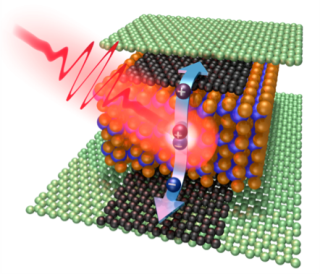Oct 7 2015
It has been shown that a combination of a 2D crystal and graphene is capable of identifying optical pulses with a staggeringly fast response time of less than ten picoseconds, with no compromise in efficiency.
 graphene/WSe2 (2D material)/graphene heterostructure. Credit: ICFO-Fabien Vialla
graphene/WSe2 (2D material)/graphene heterostructure. Credit: ICFO-Fabien Vialla
Today, optical communication systems are driven by the rapid detection of light. The bandwidth used for data communication growing rapdily due to the rise of internet of things and 5G. This means there is an increasing need for much faster optical detectors capable of being coupled into photonic circuits.
The ICFO researchers were able to demonstrate, for the first time, a very high photo-response speed for a heterostructure produced from 2D materials by utilizing extremely fast laser pulses.
Devices built using graphene and other 2D materials possesscan be combined monolithically with silicon photonics, thus giving rise to a whole new range of photonic integrated circuits.
The ICFO research concentrated on the photo-detection device’s inherent properties. Going forward, teams would need to be to produce photonic circuitry model and discover methods to enhance mass production of these devices.
It is remarkable how a material which is just a few nanometers thick can have such high performance
Prof. Frank Koppens - ICFO
Everyone knew graphene could make ultrafast photodetectors, but related two-dimensional crystals were still lagging very much behind. In our work we show that by teaming up these two materials, we can obtain a photodetector that is not only ultrafast but also highly efficient.
Mathieu Massicotte - ICFO
The research findings revealed that by stacking semiconducting 2D materials with graphene in heterostructures can pave the way for advanced optoelectronic applications, such as high-speed integrated communication systems.
The study was published in the Nature Nanotechnology journal. The Fundació Cellex Barcelona, the European Research Council (ERC) and the EC under the Graphene Flagship supported the ICFO research.